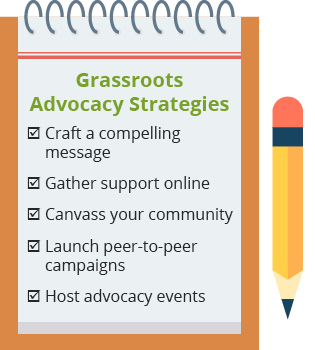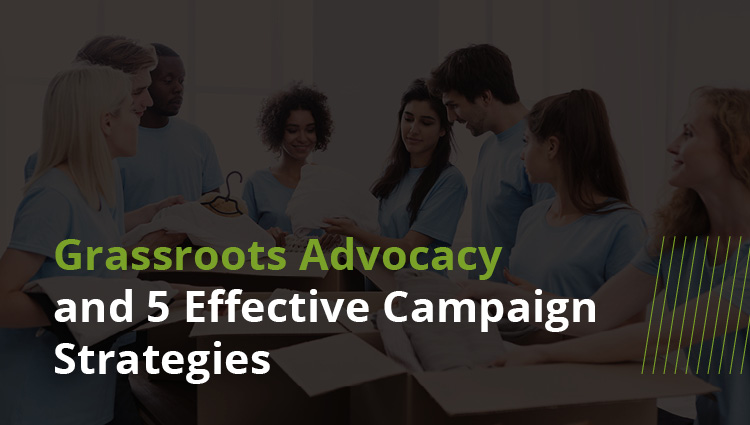Grassroots Advocacy and 5 Effective Campaign Strategies
Grassroots campaigns are built by passionate individuals coming together to make a difference for their communities. However, even the smallest grassroots advocacy campaigns have evolved in recent years, relying on new strategies to spread awareness and attract supporters.
Successful grassroots advocacy campaigns rarely come together without dedicated organization and planning. Whether your goal is to educate the public or persuade elected officials to a certain way on upcoming legislation, you’ll need the right resources and strategies backing your campaign. Today, for most grassroots campaigns, those resources and strategies revolve around technology.
To help your modern grassroots advocacy efforts, this guide will explore the basics of grassroots advocacy and dive into five tech-driven campaign strategies that can help grassroots groups make the most of current trends among successful advocacy groups:
- Grassroots Advocacy FAQ
- 5 Grassroots Advocacy Campaign Strategies
- Find the Right Grassroots Advocacy Software for Your Campaign
For many grassroots advocacy groups, improving their campaign and implementing effective strategies starts with the right advocacy software. Assess your grassroots groups’ current techstack and make note of how you can transform and upgrade your advocacy campaign to launch a truly modern grassroots movement.

Grassroots Advocacy FAQ
Before you can begin your grassroots advocacy campaign, you’ll need a strong foundational knowledge of what grassroots advocacy is and why it matters. Whether you’re an experienced advocacy professional or exploring advocacy initiatives for the first time, it’s important to refresh your knowledge on core concepts as needed.
What is grassroots advocacy?
Grassroots advocacy refers to activities, campaigns, and organizations formed and hosted by concerned individuals for the purpose of influencing political or social change.
Unlike political lobbyists, grassroots activists are individuals with a personal stake in the cause they support rather than paid representatives speaking on behalf of a business or organization. Grassroots movements can have sponsorships and partnerships with local businesses and organizations, but their members are rarely paid or receive other compensation.
Why does grassroots advocacy matter?
Grassroots advocacy movements are an investment of time and effort, and sometimes even the most well-organized campaigns will only see limited results. However, grassroots advocacy is more than worth pursuing for invested individuals. Here are a few benefits that come with grassroots campaigns:
- Concerned citizens can take action on the issues that impact their daily lives.
- Communities can be formed, allowing activists to make a greater impact together than they can individually.
- Grassroots activists can and have changed legislation, encouraging elected officials to listen more closely to the people they represent.
Organizations dedicated to social good, like nonprofits, can also use grassroots activism as a way to further their cause. For example, a nonprofit that supports environmental protection might launch an advocacy campaign to draw attention to a clean air bill or partner with a local grassroots group with the same goal.
How can you get started with grassroots advocacy?
Grassroots movements are formed when concerned individuals connect with one another. Explore your community to see if there are any groups already formed around the pressing issues you feel need attention. Organizations looking to get started with advocacy efforts should similarly research current movements in their community before launching their own, new initiatives.
If you are starting your own grassroots movement, you’ll need to study the current state of relevant political and social issues and track legislation concerning key topics relevant to your campaign. Then, use timelines for these pieces of legislation to structure your campaign, planning when you will focus on gathering, motivating, and training supporters.
Modern advocacy campaigns also need modern resources. For most advocacy organizations, these include advocacy software, extensive social networks, and support from their local community.

5 Grassroots Advocacy Campaign Strategies
Effective campaign strategies are vital to the success of both individual grassroots campaigns and grassroots organizations’ long-term stability and impact. Few grassroots groups launch one campaign without any follow-up because many organizations only find success through consistent, long-term action that can span months or even years.
Many grassroots organizations also have limited resources, meaning that making the right strategic investments is necessary for running campaigns with results that are worth their initial costs.
Successful advocacy can be measured in a variety of ways, but most grassroots organizers will likely agree that success can only be achieved when the right strategies are employed. To help inspire your campaign, here are five grassroots advocacy strategies you can adapt for your campaigns:

1. Craft a compelling message.
A strong message or narrative can generate support and inspire volunteers to sign on to your grassroots campaign. Consider all of your organization’s stakeholders when crafting your message, such as your current supporter base, elected officials you plan to reach out to, and other groups you partner with.
Crafting a compelling narrative may take several drafts to get right. You’ll also need to have multiple versions of your mission to share, based on each platform or format you intend to use. For example, the message your volunteers share while canvassing will likely be a lot more condensed and to the point than the one you share on your website, where you have space to discuss the finer points of your campaign.
If your advocacy efforts are one branch at your larger organization, consider how your campaign-specific goals fit into your organization’s overall mission. Your campaign goals will likely be a lot more specific, targeting a unique piece of legislation or a few key pieces of information you want to disperse.
For example, an animal shelter might participate in an advocacy campaign to educate the public on the importance of no-kill shelters, while the shelter’s founding mission more broadly focuses on protecting animals and finding them good homes.
2. Gather support online.
Today, online advocacy is a major component of most grassroots advocacy campaigns. Both large and small grassroots groups can benefit from using the internet to attract supporters online to join in and make a difference.
Online advocacy can be conducted by both your organization and individual supporters, though in slightly different ways. Here is how digital advocacy might look for your organization and supporters:
- Your organization will likely use online communication channels primarily as a recruiting and educational tool. Your social media posts, emails, digital newsletters, and blog posts all aim to inform and persuade potential supporters to join your cause while keeping your current base engaged.
- Individual supporters can use online platforms, such as social media, as their primary communication channels for supporting your campaign. For example, these supporters may share your organization’s social media posts, campaign on your behalf, and even use online methods to reach out to their elected officials.
Be sure to track your supporters’ online advocacy efforts. For instance, many grassroots advocacy groups encourage supporters to get in touch with their elected officials. However, you’ll want to have a system in place to see which supporters actually followed through on your call to action and sent a message on your behalf.
3. Canvass your community.
Canvassing, whether in-person or online, can help grassroots advocacy groups establish themselves in their community while generating interest, educating the public, and collecting donations.
Strategic canvassing helps your organization form personal, one-on-one connections with members of your community, earning leads for future donors and volunteers. Plus, when volunteers canvass their own communities, they’re likely to attract the attention of friends, family, and acquaintances who will be more inclined to stop for a moment to speak with a friendly face.
Before letting your volunteers loose with clipboards and pens, consider investing in canvassing software. Traditional paper forms may get the job done, but this process requires tedious data entry, as you’ll need to input collected names and contact details into your system one at a time.
By contrast, canvassing software streamlines the data entry process, automatically updating your database with each supporters’ information collected. Plus, with canvassing software, you’ll be done with having to decipher difficult handwriting or smeared signatures.
4. Launch peer-to-peer campaigns.
Your supporters have contacts outside of your organization who may be interested in donating or offering their support if properly persuaded. This is where peer-to-peer campaigns come in to boost your grassroots advocacy campaign’s momentum.
Peer-to-peer campaigns leverage your supporters’ networks to attract new supporters, more donations, and spread awareness about your campaign.
Before launching a peer-to-peer campaign, make sure you have the proper software support to stay organized. These campaigns rely on many volunteers independently campaigning on behalf of your grassroots group, meaning they often have several moving parts and can quickly become overwhelming if not adequately prepared for in advance.
Peer-to-peer software also comes in a variety of solutions, such as event-specific peer-to-peer software that can help you check in guests quickly and connect your peer-to-peer campaign to other activities at your organization.
5. Host advocacy events.
Events help raise awareness for your cause, while also building a sense of community amongst your supporters and earning your grassroots advocacy group donations. Nonprofits who recruit volunteers to help run their events can even earn more for their campaigns through volunteer grants.
Planning an event is a multi-step process, and events without proper forethought can create a fun experience for guests without establishing their organization’s message and the event’s overall purpose.
To host events that interweave your grassroots advocacy campaign’s mission while strengthening your connection to your supporters, take the following steps to plan your event:
- Choose an appropriate event type. Consider your core audience and stakeholders when selecting your event type. Expensive, exclusive galas may be appropriate for campaigns hoping to garner major donations, but are unlikely to have the same appeal a 5K or community event would with a group of grassroots supporters.
- Assemble an experienced team. While few grassroots campaigns are started by professional activists and organizers, your event team should be made up of individuals who are experienced with logistics, coordinating teams, and scheduling long-term projects.
- Recruit potential sponsors. Events can quickly rack up costs. You can decrease the financial burden and use your events as an opportunity to reach out to local businesses to sponsor your cause. Research businesses and reach out to those with missions that align with your campaign’s. Then, discuss the terms of the sponsorship with them and highlight the potential benefits they could receive for connecting their brand name with your advocacy efforts.
- Incorporate software into your event. As mentioned, peer-to-peer campaigns pair well with events, bringing in new supporters to enjoy your event activities while contributing to your cause. However, there are more software solutions that can elevate events outside of peer-to-peer software, including live streaming tools, text-to-give software, and gamification tools such as fundraising thermometers or interactive petitions.
Remember that your event begins long before guests enter your venue or log onto your virtual meeting, and it doesn’t end until you’ve thanked them for their attendance. Streamline your registration and check-in processes to provide access to your main event activities as quickly as possible. Then, after your event’s conclusion, follow up with guests to thank them for coming and deliver one last statement about your cause and their impact on it.

Find the Right Grassroots Advocacy Software for Your Campaign
Advocacy software can help you take your grassroots campaign to the next level. Grassroots advocacy starts when local community members come together, but with the right advocacy software backing them, these movements can stretch across the country.
Fortunately, you don’t need to be a tech expert to make the most of your advocacy software. The best solutions out there prioritize user convenience and simplicity, helping busy activists stay organized while running their campaigns. While almost every advocacy solution has an onboarding period in which you might experience minor slowdowns, the right solution will ultimately be a time-saving tool.
Find Software to Power Your Campaign
Grassroots campaigns are made up of diverse groups of people with a variety of concerns. This means no two campaigns are exactly the same. However, many of them will share similar software needs. Here are a few core features to look for when assessing advocacy solutions:
- Scalability. Your advocacy software should grow with your organization. Having to upgrade or outright replace your software as your grassroots group expands can lead to slowdowns, including wasted time spent researching new solutions. The right advocacy software will work for your campaign whether your organization has only a handful of staff members or is a nationwide advocacy leader.
- Reporting features. Reporting and analytics tools are one of the major benefits of advocacy software. Rather than compiling data from individual reports yourself, your software will store your data and come equipped with filters to help organize incoming information and identify trends.
- Messaging and communication tools. Grassroots advocacy fundamentally relies on other people, and your advocacy software should help you expand your network and keep in close touch with your supporters throughout your campaign.
Assess your advocacy group’s current technology and look for an advocacy software solution that fits with your unique circumstances. In addition to these basic features, most advocacy software solutions have specialized features ranging from tools that help put your supporters in touch with elected officials to robust canvassing technology.

Grassroots Unwired’s Advocacy and Canvassing Software
Grassroots Unwired’s virtual canvassing software offers grassroots advocacy groups a modern, flexible way to attract new supporters through canvassing. Grassroots groups looking to canvass their communities either in person or virtually can make the most of Grassroots Unwired’s canvassing solution with features such as:
- Turf-cutting and canvassing management. Organize your volunteers with one system by using Grassroots Unwired’s turf-cutting tool to divide digital and in-person canvassing duties.
- Multilingual, branching scripts. Help your supporters connect with a wide range of potential supporters with branching scripts and multilingual communication options.
- PCI compliant donation processor. Combine your canvassing tools and donation processor into one convenient solution, allowing your supporters to gather donations while reaching out to members of your community.
- Real-time reporting. Stay connected to your volunteers with real-time data updates, giving your grassroots group the ability to spot challenges and take advantage of opportunities as they arise without extensive reorganizing.
- Virtual face-to-face meeting support. It can be difficult to make a personal connection through virtual meetings. With Grassroots Unwired, connect with members of your community through digital door-knocking, allowing your volunteers to host and record video calls.
Grassroots Unwired’s virtual canvassing solution is built to help bring concerned supporters together even when they are physically remote. This solution allows your organization to continue advocating even in the face of disruptions to in-person activities.
Wrap Up
Running a grassroots advocacy campaign requires staying on top of many changing, complex trends while managing a wide range of supporters with unique concerns and interests. While the variety of moving parts can make running a grassroots advocacy campaign intimidating, proper research and investment in cost-effective resources can reduce many administrative and technological burdens.
Adapting popular advocacy strategies to work for your campaign requires analysis of both your current efforts and long-term goals. Here are a few guides to help you learn more and get started with the right tools:
- Advocacy Software: 14 Top Platforms to Inspire Action. Your advocacy software is the heart of your campaign’s management. Explore your options with these fourteen platforms.
- Peer-to-Peer Fundraising Software: 15 Inspiring Platforms. Peer-to-peer campaigns leverage your supporters networks’ to spread the word about your campaign even further. Learn how to support your peer-to-peer efforts with the right software platform.
- 9 Canvassing Tips to Energize Your Political Campaigns. Prepare your canvassing team for success by studying how to make the most of this advocacy strategy.





3 Comments so far
4 Tips for Virtual Campaigning – The Nonprofit Daily NewsPosted on10:38 am - May 11, 2022
[…] Many grassroots advocacy campaigns start with groups of concerned individuals coming together over a common cause. To expand your grassroots network further online, have your nonprofit implement the following tips: […]
5 Tips for Online Engagement – Social Media BlogPosted on7:42 pm - Aug 3, 2022
[…] digital advocacy campaigns are a possibility to advance your mission by way of grassroots action and introduce extra potential supporters to your trigger. In fact, there are a lot of different […]
4 Tips For Using Advocacy Communications In Your Content Marketing – Get PremisePosted on2:20 am - Nov 9, 2022
[…] grassroots advocacy campaign is an effective way to bring attention to a specific issue or cause. Using paid advertisements, the […]